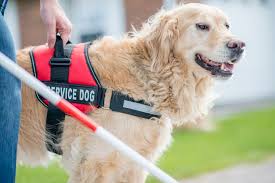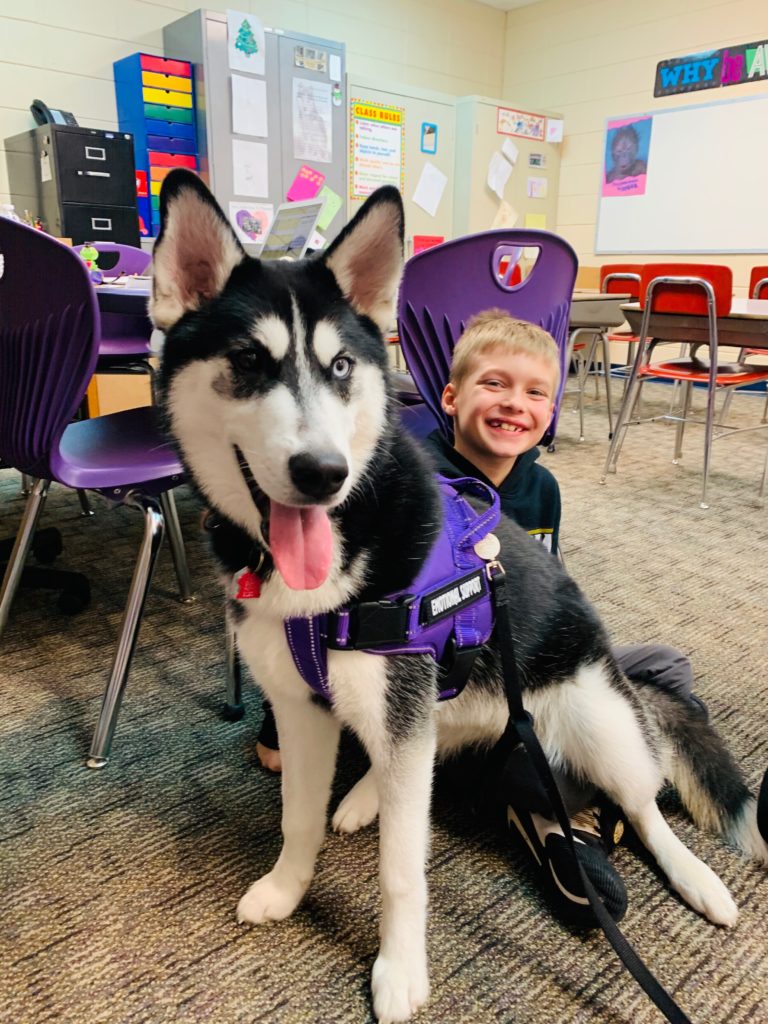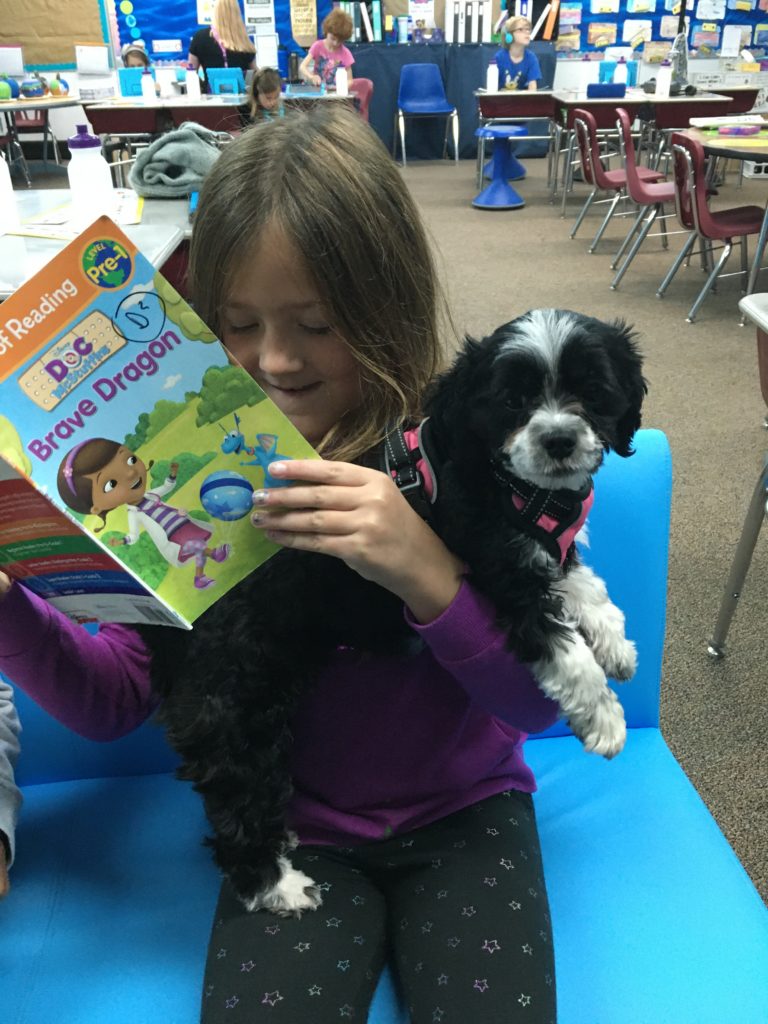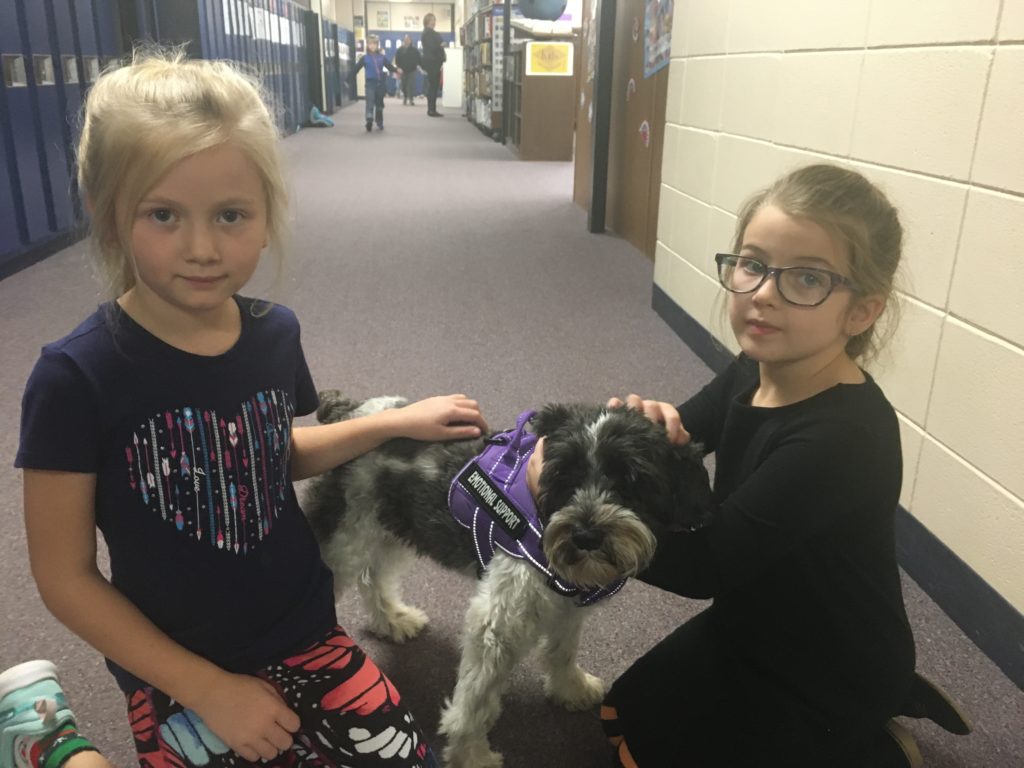Have you ever wanted to bring your pet to work? Well…. it might just be possible. And it may just improve the overall physical and mental health of staff and students. It has at our school! Therapy dogs are taking over classrooms around the nation.

You see them all the time, practically everywhere you go. The hospital, courthouse, mall, airports, hotels…. Full-time therapy dogs in schools are a fairly new concept and are becoming increasingly more popular. Our school district now has 8 therapy dogs. Our superintendent is a dog lover but above all else, was inspired by the positive impact therapy dogs can have on students and students are his number one priority. Check out how our school uses therapy dogs!
Therapy Dogs Vs. Service Dogs
It is important to note that THERAPY DOGS ARE NOT SERVICE dogs! I have to admit that when I made this video earlier in the school year that I didn’t know that there was a difference. I have since learned. There is a HUGE difference between service dogs and therapy dogs.
Service Dogs
A service dog offers assistance to its owner and is trained to specifically focus attention to its owner to the exclusion of all others. Service dogs are trained to offer specific support for individuals with disabilities such as visual, hearing or mobility difficulties or specific medical needs such as diabetes, seizure disorder, anxiety or PTSD. The role of a therapy dog is to react and respond to people and their environment under the guidance and direction of their owner.

Therapy Dogs
Therapy dogs can be used for specific animal-assisted therapy carried out by a trained counselor or health care professional. Healthcare professionals have been using therapy dogs for years. This aims to provide improvement for a person’s social, cognitive or emotional functioning. A professional who uses a therapy dog in treatment may be viewed as less threatening, potentially increasing the connection between the client and the professional. They can also be used in a more casual way, with animal-assisted activities. By just being present, available to pet and interact with students to improve emotional, physical or mental health just with the presence of a dog. These activities don’t need to be overseen by a healthcare professional.

What Does The Research Say?
Research suggests that therapy dogs in response to traumatic events can help reduce anxiety, depression and traumatic stress disorder. Just interacting with a dog can have a multitude of positive effects. Therapy dogs have been shown to physiologically reduce stress in humans by helping control cortisol levels. Cortisol can help control blood sugar levels, regulate metabolism, help reduce inflammation, and assist with memory formulation. It has a controlling effect on salt and water balance and helps control blood pressure. Interactions with a dog can also increase attachment responses that trigger oxytocin levels, a hormone that increases trust in humans. It has physical and psychological effects, including influencing social behavior and emotion. Research shows that it may benefit people with an autistic spectrum disorder (ASD) and anxiety among other things.

Benefits Of Therapy Dogs In Schools
Therapy Dogs Can:
- Help teach empathy and appropriate interpersonal skills
- Reduce Stress
- Improve one’s skill to pick up social cues
- Increase student engagement
- Help improve social skills
- Improve motivation to learn
- Give students responsibility to take care of something other than themselves
- Increase school attendance
- Increase confidence in students
- Decrease anxiety and undesirable behaviors
- Enhance relationships with peers and build more trusting relationships

A recent report found that children who work with therapy dogs in school experienced increased motivation for learning, resulting in improved outcomes. In addition to being available to all students, therapy dogs in schools are also being used with students with social-emotional learning needs. This, in turn, has been linked to increases in literacy development. Research into the effects of therapy dogs in schools is showing a range of benefits including an increase in school attendance, gains in confidence, decrease in learner anxiety, positive changes towards learning such as increases in reading and writing scores and enhanced relationships with peers.

Aren’t Dogs In School Risky?
Despite the known benefits of therapy dogs in schools, some schools choose not to partake in the program due to some perceived risks. These range from sanitation concerns, allergy concerns and concerns of student safety due to temperament.

Dealing With Allergens
There is a certain protocol that is suggested that schools follow to help with students who may have allergies to dogs. First, there are certain breeds of dogs that are better for individuals with allergies. Hypoallergenic dogs refer to dogs that don’t shed much hair or dander. In the US there are 15 breeds of dogs that are considered the best match for allergy sufferers. These include the Affenpinscher, Basenji, Bedlington Terrier, Bichon Frise, Hairless Chinese Crested, Havanese, Irish Water Spaniel, Kerry Blue Terrier, Komondor, Poodle, Portuguese Water Dog, Puli, Giant Schnauzer, Shih Tzu, Wire Fox Terrier, Yorkshire Terrier. Click here for more options from the American Kennel Club (AKC).

It is also suggested to keep the dog’s environment and equipment (vests, dog beds, collars and leashes) clean and use anti-dander spray. Teach proper handwashing techniques to all staff and students will help as well. Luckily all schools have janitors that pretty much work around the clock including day janitors and night janitors that are constantly keeping our schools clean. Accommodations of meeting the student with allergies in an alternative location or keeping the therapy dog in a certain space. It’s also important to work with the student and parents to understand their specific needs.
Dog Temperament & Training
All school therapy dogs need to first get approval from the school board and school administration. They then need to go through the AKC’s S.T.A.R. Puppy (if under a year old) and Canine Good Citizen programs, in addition to more advanced work for therapy dogs. This assures that all dogs will have a temperament that is appropriate for a school setting.
They also need to earn a facility dog designation to learn how to respond to situations that are unique to a school building. For example, when you have lunches lined up in the hallway, you have to make sure that the dog knows to not poke his head in everybody’s bag, Or what happens when a fire alarm goes off, or noises such as kids laughing, balls bouncing and there is a hallway full of kids wanting to touch them.
Our therapy dogs work with a certified dog trainer. They start out at his facility then move into training in a school setting with the trainer and owner. In addition to passing all temperament tests, our dog trainer has our dogs go through, they also need to be approved by our local Paws Board in our town.